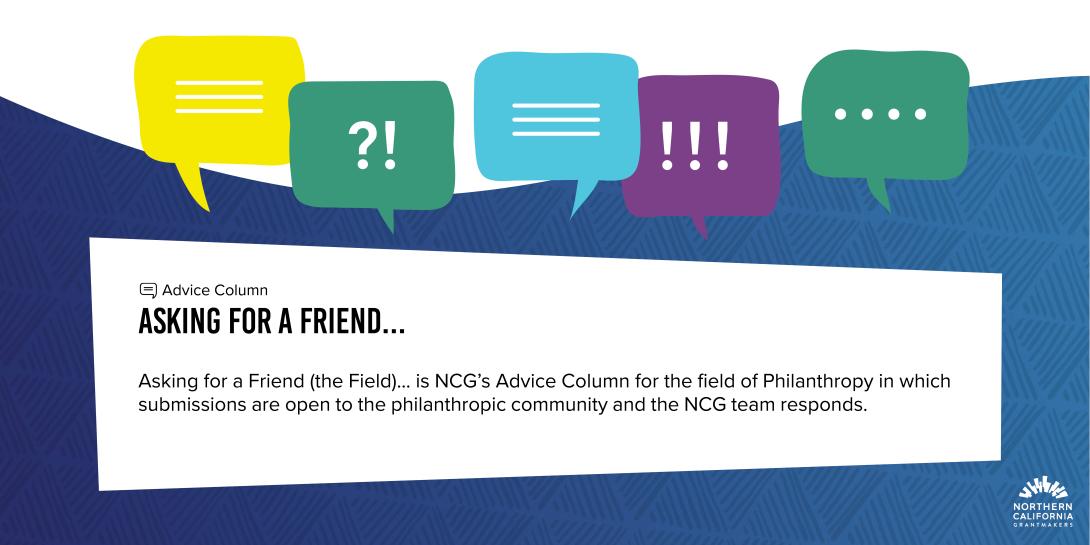Asking for a friend....why are so many foundations unwilling to give more than the minimum payout?

Want to join the conversation? Submit your question below! While we can't get to every question, the NCG team will work to respond to questions as we're able.
Conundrum
Why do y’all think so many foundations are unwilling to give out more than the minimum *payout? How can we convince larger foundations to give more than what is legally required?
Columnist
This week's column was written by Caitlin Brune. Thank you Caitlin for sharing your wisdom with the field!
Advice
Dear Miguel,
Thanks for raising these questions. They’ve come up more frequently in philanthropy since the COVID-19 pandemic, racial uprisings, and ever-increasing wealth inequality. Real Talk about money, power, race, resource allocation, and reparations feels particularly timely given endowment assets hit $1.6 trillion at last count. And you’re right, Miguel—trend data reveals that larger foundations consistently choose the minimum (5%) payout rate.
The choice to give 5%—or more—connects to a foundation’s and its founding donor(s)’s intent, political analysis, theory of change, and understanding of philanthropy’s and individual foundations’ roles. Adherence to the legal minimum payout may spring from good intentions: to maintain family connections and build a shared legacy; to be a sustained funding source in a particular place; or to resource solutions to a huge thorny problem unwaveringly. However, it continues to concentrate wealth among a privileged few. It bears mentioning that the vast majority of foundations’ endowment assets (95%) also remain invested in an extractive economy, unaligned with mission, under management by advisors trained to prioritize profit and growth in ways that harm people and planet and continue to concentrate wealth among the already wealthy.
How do we move more foundations toward what Regan Pritzker calls “reparative generosity” and a radical reimagining of the purpose and distribution of wealth?
To change things, we can start by inviting more conversation about whether philanthropy as we currently know it should exist in perpetuity. The Stupki Foundation’s Glen Galaich and Mari Shimabukuro recently wrote about this in a Mic Drop piece. We can invite more reckoning with how power plays out relationally, practicing sustained double-digit payout, using 100% mission-aligned investment practices, and spending out all assets as a gesture toward reparations, among other practices. Regarding payout rates, we can start dialogue-toward-action around some big questions:
- What are the potential upsides and downsides of foundations giving only 5% for the foreseeable future? Of giving more than 5%?
- What commitments and strategies support foundations to hold tension between current and future impact?
- As high-net-worth individuals continue to launch philanthropic initiatives, how can foundations go “all in” at this moment while taking an ecosystem approach to organizing mission-aligned peer foundations and donors to sustain long-term giving?
- How might private philanthropy use its grantmaking and investments to redistribute wealth into communities, making communities and nonprofits less reliant on institutional philanthropy, rather than sustaining imbalances in power and wealth?
Pragmatically, how can we convince foundations to increase payout? We can:
- Reframe “fiduciary responsibility.” Ask: To whom and to what are we responsible? At whose gain and whose expense? Rather than protecting an institution’s financial viability in perpetuity, champion fiduciary responsibility as nourishing a whole ecosystem of change that supports the foundation’s broadest mission.
- Develop authentic relationships with those systematically excluded from building wealth and use relationality to motivate generous wealth redistribution as reparative actions. See this blog series for an example.
- Shift narratives around “whose money” foundations are stewarding.
- Learn about and advocate for reparations & redistribution. Tell the true story of wealth and the need for reparative actions.
- Open up conversations about strategic lifespan and spending out.
- Advocate for policy changes that mandate higher payout rates for foundations and Donor Advised Funds.
- Advocate for progressive wealth taxation so that fewer resources become enclosed in foundations and giving vehicles where control of distribution rests in a few hands.
If you’re interested in more technical analyses of the “why,” Miguel, have a look at the facts and additional links and resources below.
Most importantly, we can normalize doing things differently. Change happens when there’s external and internal pressure. With external accountability mechanisms sorely lacking in philanthropy, those of us keen to disrupt the norm of adhering to the 5% payout can make it personally and professionally untenable to give only 5%. Have a conversation. Make a recommendation to do things differently. Back it up with action. Join an advocacy organization and lend your energy and voice. You can be a force for pushing that needle well beyond the minimum.
Gratefully,
Caitlin
Fast facts:
- Every foundation is free to determine its own payout percentage as long as it equals or exceeds 5%.
- That percentage does not need to be the same every year.
- Many foundations calculate annual payout budgets based on the rolling average of the prior three or five years of returns on investment.
- Fiduciary duty for a foundation entails ensuring funds are used to realize the charitable intent of the donor. Using foundation funds to further that intent may, under certain conditions, take precedence over maximizing the future value of the endowment.
- For private foundations, the normal fiduciary obligation to grow the endowment as much as is prudently possible does not take priority over the charitable mission.
Additional links and resources:
- Foundation giving and payout in 2022: What changed and what’s next
- The Truth about Private Foundations and the 5% Payout Rule
- Foundations Can Increase Payouts: Here’s How
- The 5% Payout May Be a Floor, But the Ceiling is Awfully Low
- Strategies for Scaling Philanthropic Impact Through Values-Aligned Investing
- Justice Funders’ Just Transition Investment Community
*“Payout” is defined to include grants, program- and mission-related investments, administrative overhead, and trustee compensation.






